The ABCs of Baby-Led Weaning!
Here’s everything you need to know about Baby-Led Weaning (BLW). When babies are moving from exclusively being fed breast milk and/or formula to starting solids, they will typically begin with pureed foods that they are fed with a spoon. However, Baby-Led Weaning, as the term suggests, lets your baby take the lead on how this should go.
All babies give signs that they’re ready to start solids and there will also be signs that they’re interested in self-feeding. They should be able to sit upright with minimal support, preferably in an adjustable high chair. They might reach for an object, be able to grab it and move it towards their mouth. And typically, they will reduce spitting things out (called a ‘tongue-thrust reflex’). If these signs aren’t very obvious yet, even if your baby is around 6 months, you should wait.

Before you do start, speak to your paediatrician for guidance and resources. It’s also a good idea to take a child infant CPR course for your peace of mind. While studies have shown that BLW is not a higher risk for choking, it always helps to be prepared. Ensure that distractions are minimised especially when you’re first starting off, particularly the TV or other screens.
Baby-Led Weaning has multiple benefits.
Hones developmental skills including fine-motor skills as they pick up pieces of food, learn to move it to their mouth, put it in and understand how to chew which helps with oral-motor skills. We recommend a great baby serveware set like Oribel’s, which is perfect for tiny fingers and absolutely safe for tender teeth and gums. BLW helps babies learn to gauge fullness and over time, helps with self-regulation and reduces the chances of overeating.
Exposes them to diverse foods that you and other members in your family eat. BLW presents a variety of textures and flavours so that your baby’s sensory development improves. Giving your baby the experience of lots of different foods could also reduce the possibility of a picky eater in the future.
Saves time and money because BLW means you serve your baby food similar to what you’re eating (in smaller pieces and with some variation of course). You therefore reduce the need to buy and cook something separately which can save on both prep time and your grocery bill!
Encourages interaction and learning because your baby can join in the family meal. With a feeding high chair like the Cocoon Z that fits perfectly at the dining table, your baby can sit comfortably with everyone and learn from watching you eat and chew. Even at a young age, the conversation and screen-free interaction at everyday lunches and dinners is beneficial for social skills.
Which foods are best for Baby-Led Weaning?
Purees, while mostly used for spoon-feeding, are also great for BLW in the beginning. You can hold the spoon out, let your baby take it and then proceed. Other soft foods like oatmeal and yoghurt are easy to eat with a spoon too. In the Cocoon Z baby high chair, the extra large feeding tray and the suction bowl and spoon are great for this. The high chair lets your baby eat comfortably, the bowl won’t go flying off the tray, and clean-up is a breeze!
For solids, it’s best to cut food into finger-sized slices that are easy to grasp. The food should be firm enough to hold but soft enough to chew. Our special baby-safe plate is great to display different kinds of foods and the soft spoon and fork are easy to use for solids. There’s a bib too, so we got all sorts of messes covered!
Fruits like bananas, avocado and mango work well, as well as roasted, baked or steamed veggies like carrots and sweet potato. Ground or shredded meat is also an option. Avoid whole, firm foods and hard, crunchy foods.
And finally, all babies are different and may start BLW later than 6 months, or not enjoy it at all. You may find your baby doesn’t initially eat too much while getting used to solids and needs more purees or milk. Go easy on yourself and take time to figure out what is best for your child.
Did your baby seem keen on baby-led weaning? How was the experience for both of you? We’d love to know what worked for you and if there’s something not mentioned in this article. Write to us wecare@loveoribel.com.


